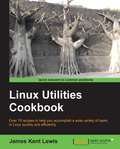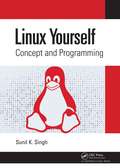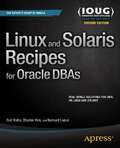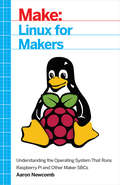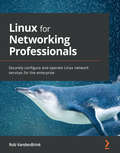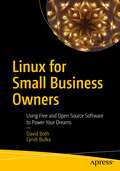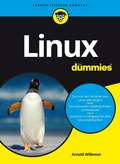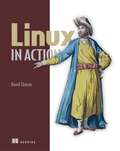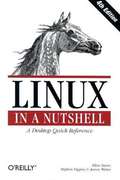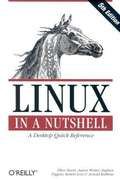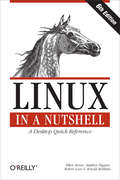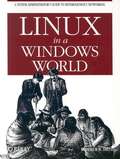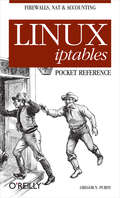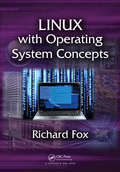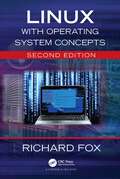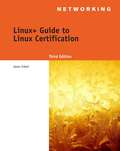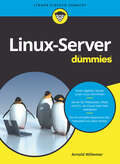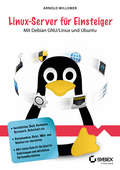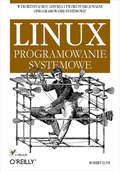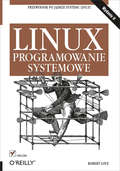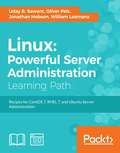- Table View
- List View
Linux Utilities Cookbook
by James Kent LewisA Cookbook-style guide packed with examples and illustrations, it offers organized learning through recipes and step-by-step instructions. The book is designed so that you can pick exactly what you need, when you need it.Written for anyone that would like to familiarize themselves with Linux. This book is perfect migrating from Windows to Linux and will save your time and money, learn exactly how to and where to begin working with Linux and troubleshooting in easy steps.
Linux Yourself: Concept and Programming
by Sunil K. SinghNumerous people still believe that learning and acquiring expertise in Linux is not easy, that only a professional can understand how a Linux system works. Nowadays, Linux has gained much popularity both at home and at the workplace. Linux Yourself: Concept and Programming aims to help and guide people of all ages by offering a deep insight into the concept of Linux, its usage, programming, administration, and several other connected topics in an easy approach. This book can also be used as a textbook for undergraduate/postgraduate engineering students and others who have a passion to gain expertise in the field of computer science/information technology as a Linux developer or administrator. The word "Yourself" in the title refers to the fact that the content of this book is designed to give a good foundation to understand the Linux concept and to guide yourself as a good Linux professional in various platforms. There are no prerequisites to understand the contents from this book, and a person with basic knowledge of C programming language will be able to grasp the concept with ease. With this mindset, all the topics are presented in such a way that it should be simple, clear, and straightforward with many examples and figures. Linux is distinguished by its own power and flexibility, along with open-source accessibility and community as compared to other operating systems, such as Windows and macOS. It is the author’s sincere view that readers of all levels will find this book worthwhile and will be able to learn or sharpen their skills. KEY FEATURES Provides a deep conceptual learning and expertise in programming skill for any user about Linux, UNIX, and their features. Elaborates GUI and CUI including Linux commands, various shells, and the vi editor Details file management and file systems to understand Linux system architecture easily Promotes hands-on practices of regular expressions and advanced filters, such as sed and awk through many helpful examples Describes an insight view of shell scripting, process, thread, system calls, signal, inter-process communication, X Window System, and many more aspects to understand the system programming in the Linux environment Gives a detailed description of Linux administration by elaborating LILO, GRUB, RPM-based package, and program installation and compilation that can be very helpful in managing the Linux system in a very efficient way Reports some famous Linux distributions to understand the similarity among all popular available Linux and other features as case studies
Linux and Solaris Recipes for Oracle DBAs
by Darl Kuhn Charles Kim Bernard LopuzLinux and Solaris Recipes for Oracle DBAs, 2nd Edition is an example-based book on managing Oracle Database under Linux and Solaris. The book is written for database administrators who need to get work done and lack the luxury of curling up fireside with a stack of operating-system documentation. What this book provides instead is task-oriented coverage designed around the needs of the Oracle Database Administrator. Find the right chapter. Look up the task to perform. See the solution. Implement the solution straight away in your own environment. Get the job done. New in this edition is coverage of Oracle's own Solaris operating system. Oracle Corporation has been working diligently to bring commonality between Solaris and Linux, and this book takes advantage of those efforts to provide task-oriented solutions that work on common distributions of Linux such as Red Hat Enterprise Linux and Oracle Enterprise Linux while also accommodating the growing number of Oracle Solaris customers. Examples in the book match the tasks DBAs perform daily, even hourly. Solutions come first in the book, but always are followed by close explanations of the details. Database administrators won't go wrong with Linux and Solaris Recipes for Oracle DBAs. It's the book to buy if you're after clear and reliable examples to help in getting the job done, and getting home to your family. Takes you directly from problem to solution Covers the "right" mix of operating-system tasks for database administrators Respects your time by being succinct and to-the-point Includes coverage of Solaris in addition to common Linux distributions What you'll learn Execute Linux and Solaris commands applicable to Oracle Database. Automate critical DBA tasks via operating-system shell scripts. Monitor, tune, and optimize Linux and Solaris servers for Oracle. Setup a VirtualBox environment for the Oracle database. Perform system administration tasks relevant to Oracle Database. Remotely (and securely!) manage Oracle on Linux and Solaris. Who this book is for Linux and Solaris Recipes for Oracle DBAs is a book for Oracle database administrators who want to expertly operate Oracle databases on the Linux and Solaris operating systems. If you're new to Linux and Solaris and can benefit from detailed examples showing how to perform tasks that Oracle DBAs perform on Linux and Solaris servers, then this book is what you need to help you get the job done, and get home on time. Table of Contents 1. Getting Started 2. Working in the Shell 3. Managing Processes and Users 4. Creating and Editing Files 5. Managing Files and Directories 6. Archiving and Compressing Files 7. Shell Scripting 8. Analyzing Server Performance 9. Viewing and Configuring System Resources 10. Automating Jobs 11. Installing and Upgrading Oracle Software 12. Virtualization Tasks 13. Optimizing Linux for Oracle Databases 14. Working Securely Across a Network 15. Managing X-Windows 16. Managing Remote Servers with VNC 17. Appendix A. Understanding RAID Concepts 18. Appendix B. Managing Log Files
Linux for Makers: Understanding the Operating System That Runs Raspberry Pi and Other Maker SBCs
by Aaron NewcombLinux is a powerful open-source operating system that has been around for many years and is widely used for running servers and websites. But most students and Makers encounter it for the first time when they are working on projects with their Raspberry Pi or similar single-board computers (SBCs) such as BeagleBone Black or Intel Galileo. Linux for Makers is the first book that explains the Linux operating system specifically for Makers, as opposed to programmers and administrators. By gaining a deeper understanding of Linux, Makers can add another useful tool to their kit that will help them build their projects more easily.Written with the Maker in mind, this book will focus mostly on Rasbian running on the Raspberry Pi as it is the most prolific in the ecosystem today. However most of the topics covered will apply broadly to other Linux distributions and will be called out when they may differ. Many times users cut and paste from a website tutorial into the Linux command line without understanding what they are actually doing only to be frustrated when they want to modify or tweak something to suit their needs. Also, many Makers shy away from using the Raspberry Pi or similar board because they feel Linux is too foreign and they think using a command line will be more difficult than using a GUI. This book aims to overcome those fears and provide a foundation for further learning and exploration. To that end, this book will focus on the basic principles that a Maker would need to know as opposed to other resources that go into detail that is not particularly relevant to building projects.
Linux for Networking Professionals: Securely configure and operate Linux network services for the enterprise
by Rob VandenBrinkGet to grips with the most common as well as complex Linux networking configurations, tools, and services to enhance your professional skillsKey FeaturesLearn how to solve critical networking problems using real-world examplesConfigure common networking services step by step in an enterprise environmentDiscover how to build infrastructure with an eye toward defense against common attacksBook DescriptionAs Linux continues to gain prominence, there has been a rise in network services being deployed on Linux for cost and flexibility reasons. If you are a networking professional or an infrastructure engineer involved with networks, extensive knowledge of Linux networking is a must.This book will guide you in building a strong foundation of Linux networking concepts. The book begins by covering various major distributions, how to pick the right distro, and basic Linux network configurations. You'll then move on to Linux network diagnostics, setting up a Linux firewall, and using Linux as a host for network services. You'll discover a wide range of network services, why they're important, and how to configure them in an enterprise environment. Finally, as you work with the example builds in this Linux book, you'll learn to configure various services to defend against common attacks. As you advance to the final chapters, you'll be well on your way towards building the underpinnings for an all-Linux datacenter.By the end of this book, you'll be able to not only configure common Linux network services confidently, but also use tried-and-tested methodologies for future Linux installations.What you will learnUse Linux as a troubleshooting and diagnostics platformExplore Linux-based network servicesConfigure a Linux firewall and set it up for network servicesDeploy and configure Domain Name System (DNS) and Dynamic Host Configuration Protocol (DHCP) services securelyConfigure Linux for load balancing, authentication, and authorization servicesUse Linux as a logging platform for network monitoringDeploy and configure Intrusion Prevention Services (IPS)Set up Honeypot solutions to detect and foil attacksWho this book is forThis book is for IT and Windows professionals and admins looking for guidance in managing Linux-based networks. Basic knowledge of networking is necessary to get started with this book.
Linux for Small Business Owners: Using Free and Open Source Software to Power Your Dreams
by David Both Cyndi BulkaLearn how you can take complete control and run your small business with powerful, free open source software (FOSS). This book introduces small business owners to the power and security of Linux and other FOSS tools to manage any small business as well as the many advantages it has over expensive, proprietary software. While exploring the reasons for using Free Open Source Software, you'll investigate the assertion that, “The value of any software lies in its usefulness not in its price,” set forth by Linux Torvalds, the creator of Linux. This book examines the use of Linux and also the other Free Open Source Software you need to meet your business challenges including the usual accounting, Email, web browsing, word-processing tasks. You will be introduced to advanced tools such as those that enable you to create audio and video clips you can use to promote your business or that can even be your primary product, such as how-to instruction.Most small business owners perform many tasks including that of administering their computers. This book shows you how to find and install new software you need to run your business and keep it up to date using the tools already provided by Linux and the secure, trusted repositories available online. It also explores how to decide which tasks to do in-house and which you might want to sub out to external resources such as advertising and contact services to attract and keep customers. Linux for Small Business Owners provides some logic, reason, and explanation for each of the steps that are needed and the tools used to implement Linux in your small business. It is a detailed guide to removing Windows from your computers and installing Linux and some commonly used open source software like the LibreOffice suite of programs, accounting, and other software useful to many small businesses. It also provides the information and tools necessary to manage and maintain Linux and applications up-to-date and secure.What You'll Learn Understand what the term "free/open source" means and how you can apply it to your business.Look at the operational and financial advantages of using Free Open Source Software instead of expensive, proprietary software.See why you will never need to pay for anti-virus and anti-malware software again.Replace expensive software like Microsoft Office with open source tools such as LibreOffice Review the factors required to make an informed decision about switching to Linux.Install new applications, updates to Linux, and the application software.Explore why backups are critical, how to create them, and how to use them to restore lost data. Who This Book Is For Ideal for small business owners and owner-operated small businesses looking to streamline operations, save money, time and energy managing the common problems associated with using more popular operating systems.
Linux für Dummies (Für Dummies)
by Arnold V. WillemerWollen Sie wissen, was es mit Linux auf sich hat und warum es unter Kennern eine so große Fangemeinde hat? Ziehen Sie freie Softwareanbieter den kommerziellen vor? Trauen Sie sich noch nicht zu, die eingefahrenen Pfade zu verlassen, wollen das aber? Arnold Willemer zeigt Ihnen, wie Sie zu einem eigenen Linux-System kommen. Er bevorzugt die Distribution Linux Mint MATE, da sie sehr einfach in der Bedienung ist, stellt aber auch andere Distributionen vor. Sie erfahren auch, was Sie dann mit Ihrem neuen Computer anfangen können ? Textverarbeitung, Tabellenkalkulation, Mailen und Surfen ?, wie Sie ein kleines Familien-Netzwerk einrichten und wie Sie Ihr System pflegen.
Linux in Action
by David ClintonSummaryLinux in Action is a task-based tutorial that will give you the skills and deep understanding you need to administer a Linux-based system. This hands-on book guides you through 12 real-world projects so you can practice as you learn. Each chapter ends with a review of best practices, new terms, and exercises. Purchase of the print book includes a free eBook in PDF, Kindle, and ePub formats from Manning Publications.About the TechnologyYou can't learn anything without getting your hands dirty including Linux. Skills like securing files, folders, and servers, safely installing patches and applications, and managing a network are required for any serious user, including developers, administrators, and DevOps professionals. With this hands-on tutorial, you'll roll up your sleeves and learn Linux project by project.About the BookLinux in Action guides you through 12 real-world projects, including automating a backup-and-restore system, setting up a private Dropbox-style file cloud, and building your own MediaWiki server. You'll try out interesting examples as you lock in core practices like virtualization, disaster recovery, security, backup, DevOps, and system troubleshooting. Each chapter ends with a review of best practices, new terms, and exercises. What's insideSetting up a safe Linux environmentManaging secure remote connectivityBuilding a system recovery devicePatching and upgrading your systemAbout the ReaderNo prior Linux admin experience is required.About the AuthorDavid Clinton is a certified Linux Server Professional, seasoned instructor, and author of Manning's bestselling Learn Amazon Web Services in a Month of Lunches.Table of ContentsWelcome to Linux Linux virtualization: Building a Linux working environment Remote connectivity: Safely accessing networked machines Archive management: Backing up or copying entire file systems Automated administration: Configuring automated offsite backups Emergency tools: Building a system recovery device Web servers: Building a MediaWiki serverNetworked file sharing: Building a Nextcloud file-sharing serverSecuring your web serverSecuring network connections: Creating a VPN or DMZ System monitoring: Working with log files Sharing data over a private network Troubleshooting system performance issues Troubleshooting network issues Troubleshooting peripheral devices DevOps tools: Deploying a scripted server environment using Ansible
Linux in a Nutshell, 3rd Edition
by Stephen Figgins Jessica P. Hekman Ellen Siever Stephen SpainhourThis complete reference covers all user, programming, administration, and networking commands, with options, for common Linux distributions. It also documents a wide range of GNU tools. New material in the third edition includes common configuration tasks for the GNOME and KDE desktops and the fvwm2 window manager, the dpkg Debian package manager, expanded coverage of the rpm Red Hat package manager, and many new commands.
Linux in a Nutshell, 4th Edition
by Stephen Figgins Ellen Siever Aaron WeberComprehensive but concise, Linux in a Nutshell is an essential desktop reference for the commands that users of Linux utilize every day. It covers all substantial user, programming, administration, and networking commands for the most common Linux distributions. It's several quick references rolled into one: sed, gawk, RCS, CVS, vi, Emacs, bash, tcsh, regular expressions, package management, bootloaders, and desktop environments are all covered in this clear, to-the-point volume, along with core command-lin
Linux in a Nutshell, 5th Edition
by Arnold Robbins Stephen Figgins Ellen Siever Aaron Weber Robert LoveOver the last few years, Linux has grown both as an operating system and a tool for personal and business use. Simultaneously becoming more user friendly and more powerful as a back-end system, Linux has achieved new plateaus: the newer filesystems have solidified, new commands and tools have appeared and become standard, and the desktop--including new desktop environments--have proved to be viable, stable, and readily accessible to even those who don't consider themselves computer gurus. Whether you're using Linux for personal software projects, for a small office or home office (often termed the SOHO environment), to provide services to a small group of colleagues, or to administer a site responsible for millions of email and web connections each day, you need quick access to information on a wide range of tools. This book covers all aspects of administering and making effective use of Linux systems. Among its topics are booting, package management, and revision control. But foremost in Linux in a Nutshell are the utilities and commands that make Linux one of the most powerful and flexible systems available. Now in its fifth edition, Linux in a Nutshell brings users up-to-date with the current state of Linux. Considered by many to be the most complete and authoritative command reference for Linux available, the book covers all substantial user, programming, administration, and networking commands for the most common Linux distributions. Comprehensive but concise, the fifth edition has been updated to cover new features of major Linux distributions. Configuration information for the rapidly growing commercial network services and community update services is one of the subjects covered for the first time. But that's just the beginning. The book covers editors, shells, and LILO and GRUB boot options. There's also coverage of Apache, Samba, Postfix, sendmail, CVS, Subversion, Emacs, vi, sed, gawk, and much more. Everything that system administrators, developers, and power users need to know about Linux is referenced here, and they will turn to this book again and again.
Linux in a Nutshell: A Desktop Quick Reference (Nutshell)
by Arnold Robbins Stephen Figgins Ellen Siever Robert LoveEverything you need to know about Linux is in this book. Written by Stephen Figgins, Ellen Siever, Robert Love, and Arnold Robbins -- people with years of active participation in the Linux community -- Linux in a Nutshell, Sixth Edition, thoroughly covers programming tools, system and network administration tools, the shell, editors, and LILO and GRUB boot loaders. This updated edition offers a tighter focus on Linux system essentials, as well as more coverage of new capabilities such as virtualization, wireless network management, and revision control with git. It also highlights the most important options for using the vast number of Linux commands. You'll find many helpful new tips and techniques in this reference, whether you're new to this operating system or have been using it for years. Get the Linux commands for system administration and network managementUse hundreds of the most important shell commands available on LinuxUnderstand the Bash shell command-line interpreterSearch and process text with regular expressionsManage your servers via virtualization with Xen and VMwareUse the Emacs text editor and development environment, as well as the vi, ex, and vim text-manipulation toolsProcess text files with the sed editor and the gawk programming languageManage source code with Subversion and git
Linux in a Windows World
by Roderick W. SmithThe latest in O'Reilly's line of bestselling Linux titles, Linux in a Windows World is an invaluable companion for any system administrator interested in integrating Linux into their Windows environment. This book takes an in-depth look at exactly how Linux can be brought into an organization that's currently based on Microsoft Windows systems. Featuring a litany of insider tips and techniques, Linux in a Windows World dispenses all the practical advice you need to migrate to this revolutionary open source software.
Linux iptables Pocket Reference: Firewalls, NAT & Accounting
by Gregor N. PurdyFirewalls, Network Address Translation (NAT), network logging and accounting are all provided by Linux's Netfilter system, also known by the name of the command used to administer it, iptables. The iptables interface is the most sophisticated ever offered onLinux and makes Linux an extremely flexible system for any kind of network filtering you might do. Large sets of filtering rules can be grouped in ways that makes it easy to test them and turn them on and off.Do you watch for all types of ICMP traffic--some of them quite dangerous? Can you take advantage of stateful filtering to simplify the management of TCP connections? Would you like to track how much traffic of various types you get?This pocket reference will help you at those critical moments when someone asks you to open or close a port in a hurry, either to enable some important traffic or to block an attack. The book will keep the subtle syntax straight and help you remember all the values you have to enter in order to be as secure as possible. The book has an introductory section that describes applications,followed by a reference/encyclopaedic section with all the matches and targets arranged alphabetically.
Linux para principiantes
by Jason Cannon Marcio DominguesSe quer aprender a usar Linux mas não sabe por onde começar, siga este livro. Saber por onde começar quando se inicia a aprendizagem de uma nova tecnologia pode ser um desafio, especialmente se o assunto parecer tão vasto. Pode existir tanta informação disponível que se torna difícil escolher por onde começar, ou pior, começa-se por uma via de aprendizagem e rapidamente se encontram demasiados conceitos, comandos e nuances que não estão explicadas. Este tipo de experiência torna-se frustrante e conduz a mais perguntas do que respostas. Linux para principiantes não parte de nenhum pressuposto acerca do seu conhecimento anterior de Linux. Não precisa de conhecimentos prévios para beneficiar deste livro. Será guiado passo a passo usando uma abordagem lógica e sistemática. À medida que novos conceitos, comandos ou jargão surgem, estes serão explicados em linguagem simples tornando a aprendizagem fácil para qualquer pessoa. Eis o que pode aprender se ler Linux para principiantes: *Como obter acesso a um servidor Linux se ainda não tem. *O que é uma distribuição Linux e qual escolher *Que software é preciso para se ligar a um servidor Linux a partir de Mac e Windows. *O que é SSh e como usar, incluindo criar e usar chaves SSH. *O Sistema de ficheiros e onde encontrar programas, configurações e documentos. *Comandos básicos de Linux mais comuns. *Criar, mover, eliminar e mudar o nome de pastas. *Listar, ler, criar, editar, copiar e eliminar ficheiros *Como funcionam as permissões e como decifrar o sistema de permissões do Linux *Como usar os editores nano, vi, e emacs. *Dois métodos para procurar ficheiros e pastas *Como comparar o conteúdo de ficheiros *O que são pipes, porque são uteis e como as usar. *Como comprimir ficheiros
Linux with Operating System Concepts
by Richard FoxA True Textbook for an Introductory Course, System Administration Course, or a Combination Course Linux with Operating System Concepts merges conceptual operating system (OS) and Unix/Linux topics into one cohesive textbook for undergraduate students. The book can be used for a one- or two-semester course on Linux or Unix. It is complete with revie
Linux with Operating System Concepts
by Richard FoxA True Textbook for an Introductory Course, System Administration Course, or a Combination Course Linux with Operating System Concepts, Second Edition merges conceptual operating system (OS) and Unix/Linux topics into one cohesive textbook for undergraduate students. The book can be used for a one- or two-semester course on Linux or Unix. It is complete with review sections, problems, definitions, concepts and relevant introductory material, such as binary and Boolean logic, OS kernels and the role of the CPU and memory hierarchy. Details for Introductory and Advanced Users The book covers Linux from both the user and system administrator positions. From a user perspective, it emphasizes command-line interaction. From a system administrator perspective, the text reinforces shell scripting with examples of administration scripts that support the automation of administrator tasks. Thorough Coverage of Concepts and Linux Commands The author incorporates OS concepts not found in most Linux/Unix textbooks, including kernels, file systems, storage devices, virtual memory and process management. He also introduces computer science topics, such as computer networks and TCP/IP, binary numbers and Boolean logic, encryption and the GNU’s C compiler. In addition, the text discusses disaster recovery planning, booting and Internet servers. New in this Edition The book has been updated to systemd Linux and the newer services like Cockpit, NetworkManager, firewalld and journald. This edition explores Linux beyond CentOS/Red Hat by adding detail on Debian distributions. Content across most topics has been updated and improved.
Linux+ Guide To Linux Certification (Third Edition)
by Jason W. EckertLINUX+ GUIDE TO LINUX CERTIFICATION, THIRD EDITION offers the most up-to-date information to empower users to successfully pass CompTIA's Linux+ (Powered by LPI) Certification exam, while maintaining a focus on quality, classroom usability, and real-world experience. This complete guide provides not only the conceptual knowledge, but also the hands-on skills necessary to work with the Linux operation systems in a network administration environment. Comprehensive coverage includes updated information pertinent to the latest Linux distributions, as well as new storage technologies such as LVM and ext4. Readers will learn about new and expanded material on key job-related networking services including FTP, NFS, Samba, Apache, DNS, DHCP, NTP, RADIUS, LDAP, Squid, Sendmail, Postfix, X, SSH, VNC, SQL, and updated information on security practices and technologies. The Hands-On Projects help learners practice new skills, and review questions and key terms reinforce important concepts.
Linux-Server für Dummies (Für Dummies)
by Arnold V. WillemerLinux-Server aufsetzen, administrieren und absichern: Arnold Willemer zeigt Ihnen in diesem Buch, wie Sie Ihren Debian/GNU Linux oder Ubuntu Server von Anfang an gut im Griff haben. Schritt für Schritt erklärt er Ihnen, wie Sie den Server installieren, Laufwerke und Netzwerke einrichten und Benutzerkonten anlegen. Außerdem lernen Sie, wie Sie effizient mit der Shell arbeiten und per Remote-Zugriff administrieren. Einen weiteren großen Themenkomplex bildet die Sicherung von Daten, die Systemdiagnose sowie das Härten des Servers gegen Angreifer von außen. In weiteren Kapiteln erfahren Sie, wie Sie Datenbanken anlegen oder einen Dateiserver mit SAMBA einrichten. Und auch Mail- und Webserver kommen nicht zu kurz. Alle Themen werden anschaulich und von Grund auf erklärt, sodass Sie den Beschreibungen auch dann leicht folgen können, wenn Sie bisher noch nicht mit Linux-Servern gearbeitet haben. Zudem eignet sich dieses Buch auch hervorragend als Nachschlagewerk. So gerüstet steht Ihrem sicheren und performanten Server nichts mehr im Weg!
Linux-Server für Einsteiger: Mit Debian GNU/Linux und Ubuntu
by Arnold V. WillemerLinux-Server aufsetzen, administrieren und absichern: Arnold Willemer zeigt Ihnen in diesem Buch, wie Sie Ihren Debian/GNU Linux oder Ubuntu Server von Anfang an gut im Griff haben. Schritt für Schritt erklärt er Ihnen, wie Sie den Server installieren, Laufwerke, Drucker und Netzwerke einrichten und Benutzerkonten anlegen. Außerdem lernen Sie, wie Sie effizient mit der Shell arbeiten und per Remote-Zugriff administrieren. Einen weiteren großen Themenkomplex bildet die Sicherung von Daten, die Systemdiagnose sowie das Härten des Servers gegen Angreifer von außen. In weiteren Kapiteln erfahren Sie, wie Sie Datenbanken anlegen oder einen Dateiserver, wie z. B. einen SAMBA- oder FTP-Server, einrichten. Und auch Mail- und Webserver kommen nicht zu kurz. Alle Themen werden anschaulich und von Grund auf erklärt, sodass Sie den Beschreibungen auch dann leicht folgen können, wenn Sie bisher noch nicht mit Linux-Servern gearbeitet haben. Zudem eignet sich dieses Buch durch die vielen nützlichen Optionsübersichten auch hervorragend als Nachschlagewerk. So gerüstet steht Ihrem sicheren und performanten Server nichts mehr im Weg!
Linux. Leksykon kieszonkowy. Wydanie II
by Daniel J. BarrettNiezb?dny pomocnik ka?dego u?ytkownika Linuksa!Linux to najcz??ciej wybierany system operacyjny dla instalacji serwerowych. Jego wydajno??, stabilno?? i mo?liwo?ci nie maj? sobie równych. Te atuty zosta?y dostrze?one równie? przez u?ytkowników domowych. System ten jest coraz cz??ciej instalowany na ich komputerach. Graficzne ?rodowisko pracy, takie jak GNOME czy KDE, robi ?wietne wra?enie na u?ytkownikach systemu operacyjnego g?ównego konkurenta. Jednak wielu z wielbicieli Linuksa wci?? najbardziej ceni konsol? — ona kryje w sobie prawdziw? si??!"Linux. Leksykon kieszonkowy" to ksi??ka dla tych, których do Linuksa zniech?ca konieczno?? zapami?tania niezliczonej ilo?ci polece? i parametrów, oraz dla tych, którzy pracuj? z nim na co dzie? i potrzebuj? podr?cznej ?ci?gi. Znajdziesz tu zestawienie polece? najcz??ciej u?ywanych w codziennej pracy. Ponadto dowiesz si?, jak dopasowa? system do w?asnych potrzeb oraz jak programowa? skrypty pow?oki. W trakcie lektury przekonasz si?, ?e wiele zada? szybciej wykonasz w trybie tekstowym ni? graficznym. Ksi??ka ta jest nieocenionym pomocnikiem ka?dego u?ytkownika systemu Linux, dlatego warto mie? j? pod r?k?!Dowiedz si?: jak stosowa? wyra?enia regularnejak zarz?dza? u?ytkownikamijak b?yskawicznie porównywa? zawarto?? plikówKsi??ka, któr? musisz mie? zawsze pod r?k?!
Linux. Programowanie systemowe
by Robert LoveWykorzystaj moc Linuksa i twórz funkcjonalne oprogramowanie systemowe!Jak zarz?dza? plikowymi operacjami wej?cia i wyj?cia?Jak zablokowa? fragmenty przestrzeni adresowej?Jak sterowa? dzia?aniem interfejsu odpytywania zdarze??Dzisiaj systemu Linux nie musimy ju? nikomu przedstawia?, dzi?ki swojej funkcjonalno?ci i uniwersalno?ci sta? si? niezwykle popularny i szeroko wykorzystywany. Dzia?a wsz?dzie ― poczynaj?c od najmniejszych telefonów komórkowych, a na pot??nych superkomputerach ko?cz?c. Z Linuksa korzystaj? agencje wywiadowcze i wojsko, jego niezawodno?? doceni?y równie? banki i instytucje finansowe. Oprogramowanie z przestrzeni u?ytkownika w systemie Linux mo?e by? uruchamiane na wszystkich platformach, na których poprawnie dzia?a kod j?dra.Czytaj?c ksi??k? "Linux. Programowanie systemowe", dowiesz si?, jak utworzy? oprogramowanie, które jest niskopoziomowym kodem, komunikuj?cym si? bezpo?rednio z j?drem oraz g?ównymi bibliotekami systemowymi. Opisany zosta? tu sposób dzia?ania standardowych i zaawansowanych interfejsów zdefiniowanych w Linuksie. Po lekturze napiszesz inteligentniejszy i szybszy kod, który dzia?a we wszystkich dystrybucjach Linuksa oraz na wszystkich rodzajach sprz?tu. Nauczysz si? budowa? poprawne oprogramowanie i maksymalnie je wykorzystywa?.Programowanie systemoweBiblioteka j?zyka CKompilator j?zyka CInterfejs odpytywania zdarze?Zarz?dzanie procesami i pami?ci?U?ytkownicy i grupyOgraniczenia zasobów systemowychZarz?dzanie plikami i katalogamiIdentyfikatory sygna?ówStruktury danych reprezentuj?ce czasKonwersje czasu Poznaj i ujarzmij pot?g? Linuksa!
Linux. Programowanie systemowe. Wydanie II
by Robert LovePrzewodnik po j?drze sytemu Linux!J?dro systemu Linux to jeden z najwi?kszych projektów rozwijanych przez ogromn? spo?eczno??. Setki wolontariuszy dniami i nocami rozwijaj? najwa?niejszy element tego systemu operacyjnego. I robi? to naprawd? skutecznie! Ka?de kolejne wydanie Linuksa zawiera dziesi?tki nowinek oraz ulepsze? - jest coraz szybsze, bezpieczniejsze i po prostu lepsze. Jednak pocz?tkuj?cy programi?ci mog? mie? problemy z wykorzystaniem us?ug dostarczanych przez kernel. Masz obawy, ?e nie odnajdziesz si? w g?szczu mo?liwo?ci wspó?czesnego j?dra systemu Linux?Ta ksi??ka rozwieje je w mig. Jest to wyj?tkowa pozycja na rynku wydawniczym, zg??biaj?ca w?a?nie te tajemnice. W trakcie lektury nauczysz si? tworzy? niskopoziomowe oprogramowanie, które b?dzie si? komunikowa?o bezpo?rednio z j?drem systemu. Operacje wej?cia i wyj?cia, strumienie, zdarzenia, procesy to tylko cz??? elementów, które b?yskawicznie opanujesz. Ponadto nauczysz si? zarz?dza? katalogami i plikami oraz poznasz koncepcj? sygna?ów. Ksi??ka ta jest niezast?pionym ?ród?em informacji dla wszystkich programistów pracuj?cych z j?drem Linuksa. Docenisz t? lektur?!Poznaj:metody zarz?dzania procesamizastosowanie sygna?ówzaawansowane interfejsy wej?cia i wyj?ciaj?dro systemu od podszewki Poznaj j?dro systemu od podszewki!Robert Love - od wielu lat jest u?ytkownikiem i wspó?twórc? systemu Linux. Rozwija ?rodowisko graficzne GNOME oraz j?dro systemu. Pracuje jako projektant oprogramowania w firmie Google, by? te? cz?onkiem zespo?u projektuj?cego system operacyjny Android. Jest autorem licznych ksi??ek po?wi?conych programowaniu w systemie Linux.
Linux: A Comprehensive Beginners Guide to Learn and Execute Linux Programming
by Daniel JonesIf you want to learn Linux programming, there’s not a better book on the market for you. This Powerful pack of 4 books is going to assume you know absolutely nothing about Linux, then teach you everything from A-Z, some of the most significant topics that will be covered in this book are as follows: The most common and useful Linux command line tools How to write Bash scripts and automate your command line workflow How to program in C++ and Python How to understand and think about high-level programming concepts in order to become a better programmer in the end The differences between functional and object-oriented programming and how they apply to you You may be absolutely stumped and not know where to look. However, this book will teach you everything you need to know - and fast! Without mincing words, the book teaches you two programming languages, how to write scripts, and how to navigate the Linux command line very well. So what are you waiting for? Pick up a copy of this 4 Books bundle now and get to programming on Linux like a master!
Linux: Powerful Server Administration
by Jonathan Hobson William Leemans Oliver Pelz Uday R. SawantGet hands-on recipes to make the most of Ubuntu Server, CentOS 7 Linux Server and RHEL 7 Server About This Book • Get Linux servers up and running in seconds, • In-depth guide to explore new features and solutions in server administration • Maintain performance and security of your server solution by deploying expert configuration advice Who This Book Is For This Learning Path is intended for system administrators with a basic understanding of Linux operating systems and written with the novice-to-intermediate Linux user in mind. To get the most of this Learning Path, you should have a working knowledge of basic system administration and management tools. What You Will Learn • Set up high performance, scalable, and fault-tolerant back ends with web and database servers • Facilitate team communication with a real-time chat service and collaboration tools • Monitor, manage and develop your server's file system to maintain a stable performance • Gain best practice methods on sharing files and resources through a network • Install and configure common standard services such as web, mail, FTP, database and domain name server technologies • Create kickstart scripts to automatically deploy RHEL 7 systems • Use Orchestration and configuration management tools to manage your environment In Detail Linux servers are frequently selected over other server operating systems for their stability, security and flexibility advantages.This Learning Path will teach you how to get up and running with three of the most popular Linux server distros: Ubuntu Server, CentOS 7 Server, and RHEL 7 Server. We will begin with the Ubuntu Server and show you how to make the most of Ubuntu's advanced functionalities. Moving on, we will provide you with all the knowledge that will give you access to the inner workings of the latest CentOS version 7. Finally, touching RHEL 7, we will provide you with solutions to common RHEL 7 Server challenges.This Learning Path combines some of the best that Packt has to offer in one complete, curated package. It includes content from the following Packt products: 1)Ubuntu Server Cookbook 2)CentOS 7 Linux Server Cookbook, Second Edition 3)Red Hat Enterprise Linux Server Cookbook Style and approach This easy-to-follow practical guide contains hands on examples and solutions to real word administration problems and problems faced when building your RHEL 7 system from scratch using orchestration tools.
